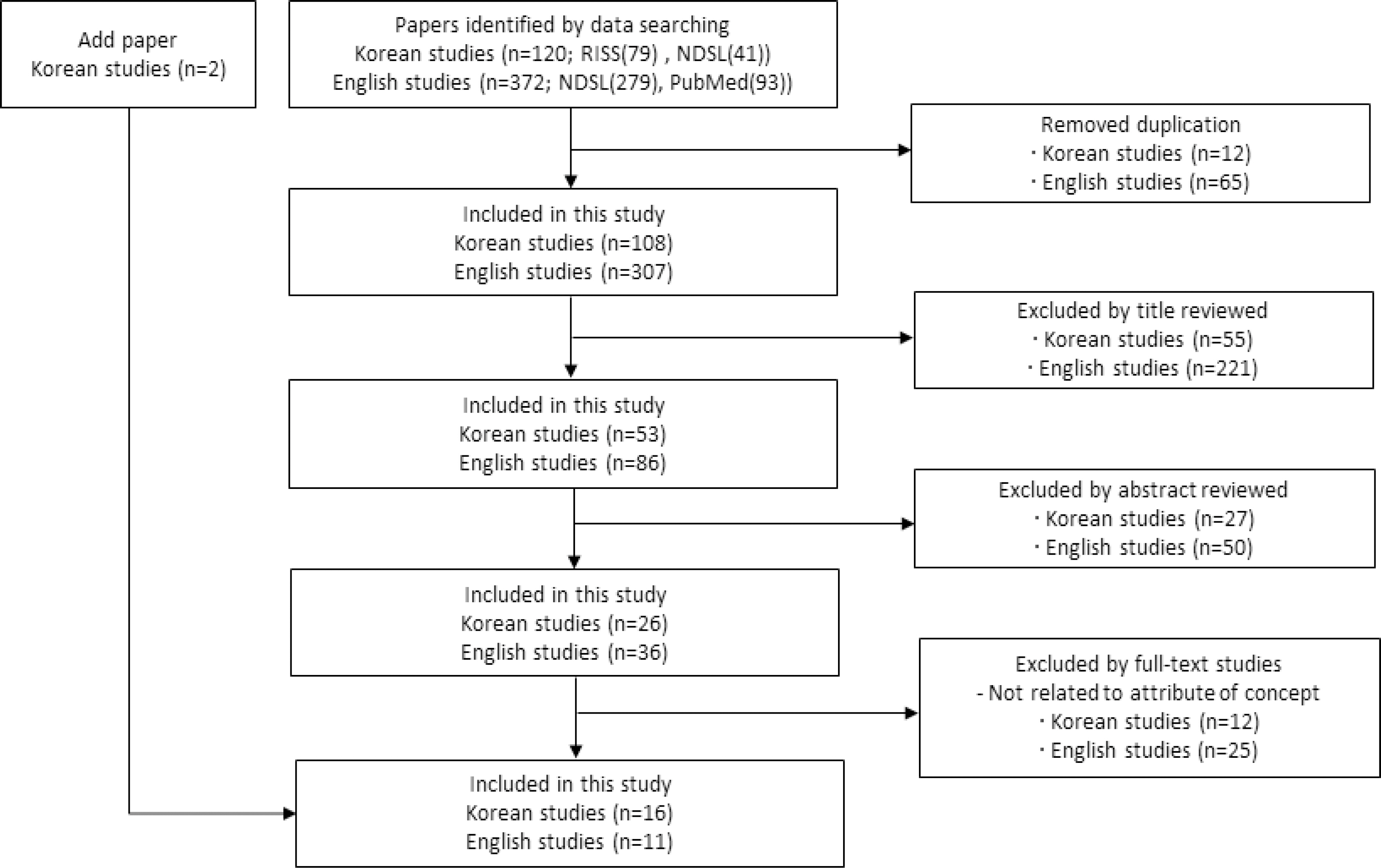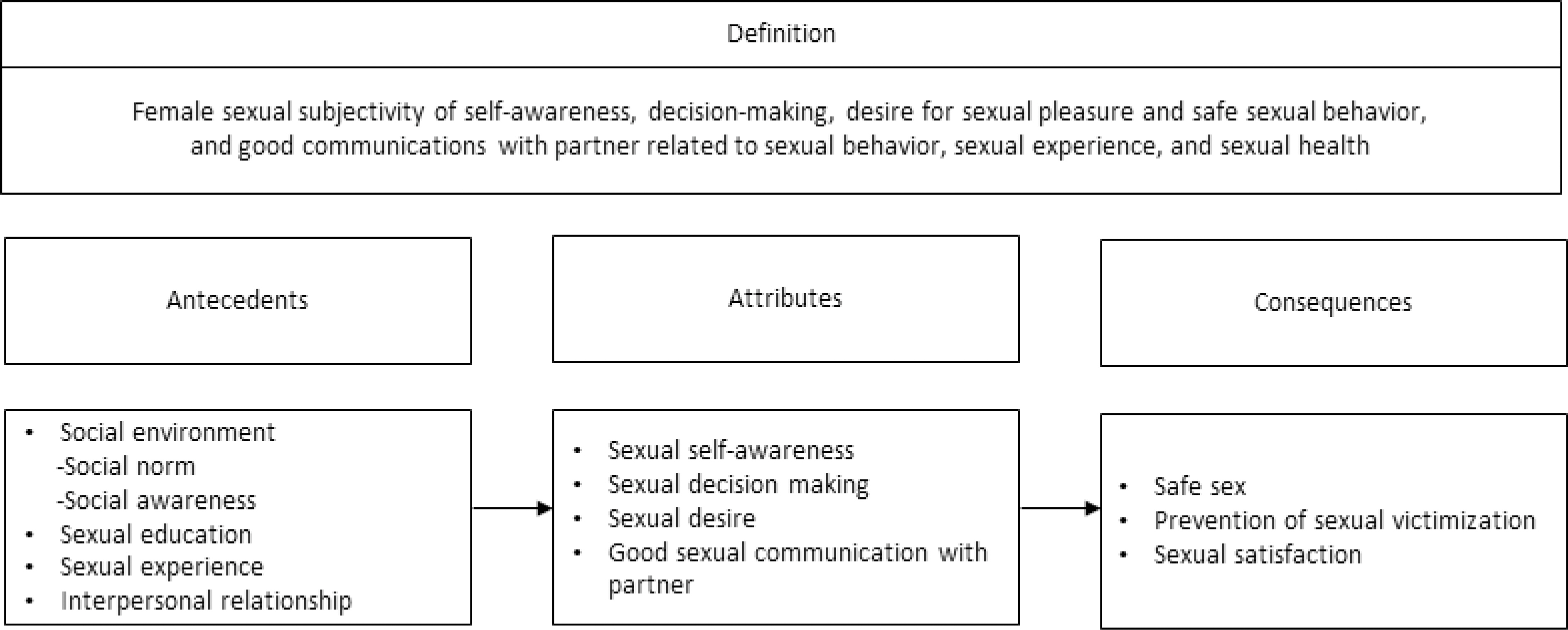Korean J Women Health Nurs.
2017 Dec;23(4):243-255. 10.4069/kjwhn.2017.23.4.243.
Concept Analysis of Female Sexual Subjectivity based on Walker and Avant's Method
- Affiliations
-
- 1Department of Nursing, The Graduate School, Yonsei University, Seoul, Korea.
- 2College of Nursing, Yonsei University, Seoul, Korea. isko16@yuhs.ac
- KMID: 2424159
- DOI: http://doi.org/10.4069/kjwhn.2017.23.4.243
Abstract
- PURPOSE
The purpose of this study was to clarify attributes, antecedents, and consequences of female sexual subjectivity.
METHODS
Walker and Avant's concept analysis process was used to analyze 27 studies from the current literature that relates to female sexual subjectivity. A systematic literature review of women's study in sociology, psychology, theology, law, health science, and nursing was reviewed.
RESULTS
The defining attributes of female sexual subjectivity were sexual self-awareness, sexual decision making, sexual desire, and good sexual communication with partner. The antecedents of female sexual subjectivity were social environment, sexual education, sexual experience, and interpersonal relationship. The consequences of female sexual subjectivity were safe sex, prevention of sexual victimization, and sexual satisfaction.
CONCLUSION
Female sexual subjectivity is defined as sexual self-awareness, sexual decision making, sexual desire to seek sexual pleasure and safety, and effective communication with partner in terms of sexual behavior, sexual experience and sexual health. Based on these results, a scale measuring female sexual subjectivity is needed.
MeSH Terms
Figure
Reference
-
References
1. Hwang SW, Chung CW. Contraception behavior and related factors in unmarried female and male. Korean Journal of Women Health Nursing. 2011; 17(1):77–87.
Article2. Lee MJ, Byun WS, Kim EJ. Sexuality and sexual violence in intimate relationship among young people. Seoul: Korean Women's Development Institute;2009. p. 247. p.3. Seo K. Reproductive health. Korean Journal of Obstetrics and Gynecology. 2009; 52(4):387–390.4. Tolman DL, Striepe MI, Harmon T. Gender matters; Constructing a model of adolescent sexual health. Journal of Sex Research. 2003; 40(1):4–12.
Article5. Buzwell S, Rosenthal D. Constructing a sexual self: Adolescents' sexual self-perceptions and sexual risk-taking. Journal of Research on Adolescence. 1996; 6(4):489–513.6. Livingston JA, Testa M, VanZile-Tamsen C. The reciprocal relationship between sexual victimization and sexual assertiveness. Violence Against Women. 2007; 13(3):298–313.
Article7. Song JE, Park SM, Park JO, Chae HJ. Effects of sexual autonomy enhancement program for university students in South Korea. Journal of Public Health. 2013; 22(2):165–174.
Article8. Chang SB. Development of sexual autonomy measurement for college students. Korean Journal of Women Health Nursing. 2002; 8(1):106–115.
Article9. Lee JY, Lee ES. Development and validation of the Korea sexual self-assertiveness scale for female. Korean Journal of Counseling. 2006; 7(1):47–62.10. Leclerc B, Bergeron S, Brassard A, Bélanger C, Steben M, Lambert B. Attachment, sexual assertiveness, and sexual outcomes in women with provoked vestibulodynia and their partners: A mediation model. Archives of Sexual Behavior. 2015; 44(6):1561–1572.
Article11. Lee EJ. Sexual self-determination rights in psychological studies. The Korean Journal of Woman Psychology. 2015; 20(3):427–441.12. Walker LO, Avant KC. Strategies for theory construction in nursing. 5th ed.Upper Saddle River, NJ: Prentice Hall;2011. p. 256. p.13. National Institute of Korean Language. Standard language dictionary [Internet]. Seoul: Author;2017. [cited 2017 September 20]. Available from:. http://stdweb2.korean.go.kr.14. Naver English Dictionary. Naver definition of sexual, subjectivity [Internet]. Seoul: Naver Corporation;2017. [cited 2017 September 20]. Available from:. http://endic.naver.com.15. Schalet A. Sexual subjectivity revisited: The significance of relationships in Dutch and American girls' experiences of sexuality. Gender & Society. 2010; 24(3):304–329.16. Mead GH. Mind, self and society. Chicago: University of Chicago Press;1934. p. 536. p.17. Gagnon JH, Simon W. Sexual conduct: The social sources of human sexuality. Chicago: Aldine;1973. p. 378. p.18. Sheff E. Polyamorous women, sexual subjectivity and power. Journal of Contemporary Ethnography. 2005; 34(3):251–283.
Article19. Lee DH. A moral-theological comment about the supportive opinion on adultery law's unconstitutionality. Catholic Theology and Thought. 2008; 62:302–327.21. Widman L, Golin CE, Noar SM, Massey J, Prinstein MJ. Pro-jectHeartforGirls.com: Development of a web-based HIV/STD prevention program for adolescent girls emphasizing sexual communication skills. AIDS Education and Prevention. 2016; 28(5):365–377.
Article22. Zimmer-Gembeck MJ, Ducat WH, Boislard-Pepin MA. A prospective study of young females' sexual subjectivity: Associations with age, sexual behavior, and dating. Archives of Sexual Behavior. 2011; 40(5):927–938.
Article23. Han EJ. A study on cause having an effect on adolescence's subjective consciousness about sexuality: centering around high school students in Busan [master's thesis]. Busan: Silla University;2003. p. 80. p.24. Choi MJ, Kong MH. The development of sex education program for improving sexual subjectivity of adolescents-focused on girls high school students. Journal of Women's Studies. 2007; 18:129–185.25. Horne S, Zimmer-Gembeck MJ. The female sexual subjectivity inventory: Development and validation of a multidimensional inventory for late adolescents and emerging adults. Psychology of Women Quarterly. 2006; 30(2):125–138.
Article26. Snell WE, Fisher TD, Miller RS. Development of the sexual awareness questionnaire: components, reliability and validity. Annals of Sex Research. 1991; 4(1):65–92.
Article27. Morokoff PJ, Quina K, Harlow LL, Whitmire L, Grimley DM, Gibson PR, et al. Sexual assertiveness scale (SAS) for women: Development and validation. Journal of Personality and Social Psychology. 1997; 73(4):790–804.
Article28. Clayton AH, Segraves RT, Leiblum S, Basson R, Pyke R, Cotton D, et al. Reliability and validity of the sexual interest and desire inventory-female (SIDI-F), a scale designed to measure severity of female hypoactive sexual desire disorder. Journal of Sex & Marital Therapy. 2006; 32(2):115–135.
Article29. Spector IP, Carey MP, Steinberg L. The sexual desire inventory: Development, factor structure, and evidence of reliability. Journal of Sex & Marital Therapy. 1996; 22(3):175–190.
Article30. Milhausen RR, Sales JM, Wingood GM, DiClemente RJ, Salazar LF, Crosby RA. Validation of a partner sexual communication scale for use in HIV/AIDS prevention interventions. Journal of HIV/AIDS Prevention in Children & Youth. 2007; 8(1):11–33.
Article



